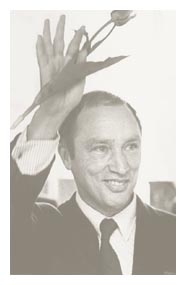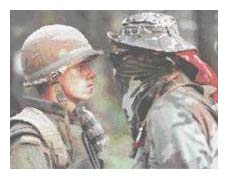Postwar Developments
Canada played an active role in the United Nations from the
time of the organization's inception after the war (see United
Nations). King retired in favor of Louis St. Laurent in 1948,
after having held office for a longer period than any other
prime minister in Canada's history (see Saint Laurent). In 1949
Newfoundland joined the Confederation as the tenth province.
In the same year Canada became a member of the North Atlantic
Treaty Organization. When the United Nations took action to
defend South Korea from invasion by North Korea, Canada contributed
units from all three branches of its armed forces. During the
hostilities (1950-53) approximately 27,000 Canadians saw service
in the Far East. The appointment of the first native-born Canadian
as governor-general occurred when the Rt. Hon. Vincent Massey
was sworn into office in 1952. Massey had been chairman of the
Royal Commission on National Development in the Arts, Letters
and Sciences. The St. Lawrence Seaway was opened in 1959. It
was formally dedicated by Queen Elizabeth II and President Dwight
D. Eisenhower of the United States. On Feb. 15, 1965, Canada
raised a red and white maple-leaf flag. It was adopted by Parliament
in December 1964 and was Canada's first official national flag.
Centennial of Canadian
Confederation
The year 1967 marked the 100th anniversary of the British North
America Act, which had been proclaimed on July 1, 1867, and
established the basis for the modern state of Canada. A giant
birthday party on Parliament Hill in Ottawa was attended by
Queen Elizabeth II. A highlight of the year was the Universal
and International Exhibition, known as Expo '67, held in Montreal.
Also to mark the centennial, Winnipeg, Man., was host to the
fifth Pan-American Games, and the Order of Canada was instituted
to reward Canadians for outstanding merit and service. In 1982
the British North America Act was replaced by a new constitution
for the government of Canada. Queen Elizabeth visited Parliament
Hill to proclaim the document. This completed the transfer of
constitutional powers from Great Britain to Canada.
Quebec Separatism
Beginning in the 1960s Quebec was the center of militant agitation
to separate it from Canada and establish a French-speaking nation.
In 1969 French and English were both declared the official languages
of Canada. In 1970 terrorist acts by alleged separatists were
climaxed by the kidnapping and murder of Quebec's minister of
labor and immigration, Pierre Laporte. The federal government
sent in troops and temporarily suspended civil liberties. In
1974 French became the official language of the province. A
party pledged to Quebec separatism won the 1976 provincial election
and passed several measures to strengthen the movement. Under
a controversial law adopted in 1977, education in English-language
schools was greatly restricted. The charter also changed English
place-names and imposed French as the language of business,
court judgments, laws, government regulations, and public institutions.
Although the separatist party retained power, a referendum to
make the province an independent country was rejected by the
Quebec voters in 1980. The Quebec government opposed the 1982
constitution, which included a provision for freedom of language
in education, and unsuccessfully sought a veto over constitutional
change. In 1984 the Supreme Court ruled against Quebec's schooling
restrictions. In 1987 the Meech Lake constitutional accord recognized
Quebec as a "distinct society" and transferred extensive new
powers to all the provinces. Quebec promised that it would accept
the 1982 constitution if the accord was approved by all the
rest of the provinces. The House of Commons ratified the Meech
Lake accord on June 22, 1988, but the accord died on June 23,
1990, after Newfoundland and Manitoba withheld their support.
A new set of constitutional proposals hammered out by a parliamentary
committee was agreed upon in 1992. They called for decentralization
of federal powers, an elected Senate, and special recognition
of Quebec as a distinct society. In a referendum held in October
1992, Canadians decisively turned down the constitutional changes.
Quebec voters narrowly rejected secession from Canada in a 1995
referendum.
Modern Canadian Leadership
The long period of Liberal domination in Parliament ended in
1957. The St. Laurent government was replaced when the Progressive
Conservatives (called Conservatives before 1942) took office
under the prime ministership of John G. Diefenbaker. In the
1962 elections the Progressive Conservatives lost their control
of Parliament, but no other party was able to win a majority.
Diefenbaker, as leader of the largest minority party, formed
a weak coalition government. In February 1963 his government
fell on the issue of Canada's failure to execute its 1958 commitments
to accept nuclear weapons from the United States for the joint
defense of North America. In general elections on April 8 the
Liberals won more seats than any other party, and Liberal leader
Lester B. Pearson was named prime minister of Canada in 1963
at the head of another minority government .

Prime Minister Trudeau
at the opening of the Tulip Festival in Ottawa, May 17,
1968 |
In 1968 the Liberals chose Pierre Elliott Trudeau to succeed
him. In the general elections in June, Trudeau won, with the
Liberals taking a majority. This was the first election to use
the electoral constituency boundaries of 1965. In the October
1972 elections Trudeau's Liberals won but failed to gain a majority.
They were able to stay in power with New Democratic support,
but in May 1974 Trudeau's government fell. The Liberals won
a new majority in the July parliamentary elections. Economic
issues brought about the Liberals' defeat five years later.
The Progressive Conservatives, led by Joe Clark, formed a minority
government that fell after only six months. Although Trudeau
resigned his party leadership in November 1979, he was again
named prime minister in 1980. Trudeau resigned once again in
1984 and was succeeded by John Turner on June 30. On July 9,
Turner called for dissolving Parliament and holding a new election.
He retained ministers from the Trudeau Cabinet and appointed
Trudeau supporters to the Senate, courts, and diplomatic posts.
Dissatisfaction with this continuation of Trudeau's influence
led to victory in the September election for the Progressive
Conservatives, under the leadership of Brian Mulroney. Mulroney
sought to improve relations with the United States. In October
1987 Canada and the United States reached agreement on a trade
pact to eliminate all bilateral tariffs over a ten-year period
beginning Jan. 1, 1989. The two countries signed a Great Lakes
water-quality agreement in November. Both countries agreed to
track and clean up sources of pollution. In January 1988 abortion
was legalized in Canada. Victories by Mulroney and his Conservative
party in the November 1988 elections guaranteed passage of the
free-trade agreement. The socialist New Democratic party chose
Audrey McLaughlin, the member of Parliament from the Yukon,
as its leader in 1989--the first woman to head a major Canadian
political party. While the international political climate became
more conservative, the party began to dominate Canadian leadership
in the early 1990s. New Democrats were elected premiers of the
provinces of Ontario, Saskatchewan, and British Columbia. With
his popularity slumping, Mulroney resigned in February 1993.
He was succeeded by Kim Campbell, who became the first female
prime minister in Canadian history. Campbell and the Conservatives
were annihilated in the October 1993 elections, retaining only
two seats in the House of Commons. The Liberal party won 177
seats to take control of the government, and Jean Chretien became
prime minister.
Native Peoples Issues

Standoff at Oka, 1990 |
A series of protests by native peoples swept across Canada in
1990. On March 11 a Mohawk group set up a blockade to stop the
town of Oka, Que., from expanding a golf course on 55 acres
(22 hectares) they claimed as ancestral territory. On July 11
a force of 100 Quebec police officers attacked the blockade,
setting off a gun battle in which one police officer was killed.
The Mohawks held the blockade for 11 weeks, finally surrendering
to the Army in September. Another group of Indians blockaded
the Mercier Bridge, one of the four main bridges into Montreal.
In other disputes over land claims, different Indian groups
set up several blockades of the rail lines in Ontario and in
British Columbia, disrupting freight and passenger service.
In southwestern Ontario five hydro transmission towers were
toppled in September. A Canadian National Railway bridge was
destroyed by fire. Other native peoples blocked roads and highways
to draw attention to their concerns. A group of Peigan Indians
defended a diversion of the Oldman River which they had built
to protest the construction of a dam that they said would destroy
their lands. On May 4, 1992, voters in the Northwest Territories
authorized the partition of their huge area into two separate
territories, one to become a self-governing homeland for Inuit,
or Eskimos. The eastern portion, covering 772,260 square miles
(2,000,144 square kilometers), was inhabited by about 17,500
Inuit. The new territory was to be called Nunavut, meaning Our
Land. Although the plebiscite was not binding on the Canadian
government, the agreement was expected to be ratified and to
go into effect by 1999. Later in the year the government agreed
that Indians and Inuit have the right of self-government.
Back
to Info Canada main menu
|